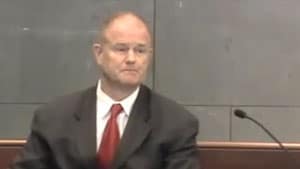

The Expert: Dr. Harry Reynolds, a colon and rectal surgeon affiliated with Cleveland Medical Center testifies for the defense and concludes the defendant healthcare providers met the standard of care under the circumstances. He also explains that he is unfamiliar in practice with “conversion disorder.”

In a 2015 medical malpractice case, the plaintiff claimed to have suffered from “conversion disorder” as a result of the inadvertent attachment of her colon to her vagina during surgery. Conversion disorder is a term applied to patients who have neurologic symptoms such as blindness, paralysis, fits, or numbness, which cause the patient significant distress, yet have no provable cause, or are not consistent with an organic cause. Testifying for the defense in this case, Dr. Harry Reynolds, a colon and rectal surgeon affiliated with University Hospitals Cleveland Medical Center, explains that a mistake was made during surgery, but that it did not constitute a deviation from the standard of care, and that despite treating many patients with similar problems, he has never seen anyone with conversion disorder.
Reynolds begins his testimony in this clip explaining how imaging demonstrates reflux of contrast dye from the patient’s vagina into her small intestine. This required significant pressure dilating the vagina with contrast dye to demonstrate the flaw causing the connection between these two organs. This defect was very small, not a large, wide-open defect as might have occurred if the vaginal cuff had actually been purposefully stapled as an anastomosis between organs. In this case, the small intestine was attached to a remaining stump of colon to reestablish intestinal continuity following colon resection.
Unfortunately, a part of the vaginal stump (the patient had a previous hysterectomy) was inadvertently included in this stapled connection. This accidental connection between vagina and colon and/or small intestine is known as a fistula and would later result in intestinal content leaking through the patient’s vagina. The X-ray examination using dye demonstrated this connection.
Reynolds then declares that the operative findings reported after the surgery to repair this defect are consistent with what was noted by the X-ray interpretation; this was a small fistula occurring due to inclusion of a small piece of vaginal cuff within the stapler during the original surgery. The surgical pathology report from the second surgery was also consistent with this theory.
Taking the radiologic studies, the second operative report, and the pathology report as well as subsequent medical records into account, Reynolds concludes that the stapler could not have been accidentally placed into the vagina instead of the rectum and then triggered to produce a rectovaginal anastomosis. The size of the stapler head would have left a much larger connection than was found in these studies and reports. It was more reasonable to assume that a small piece of vaginal tissue was included within the stapler jaws in an area that is notoriously difficult to see, requiring surgeons to observe “visual cues” rather than direct visualization before activating the stapler. Once the stapler was fired, he says, a tiny connection was created where it was not intended.
Despite this injury, the expert reports that all members of the surgical team acted within the standard of care during the original procedure, then reacted appropriately to investigate and correct the problem in a timely fashion when it became obvious that something had gone wrong. “This is all we can expect from our surgeons,” he declares.
Finally the issue of conversion disorder was addressed. Dr. Reynolds, despite many years of treating fistulas like this, has never seen such a case, and did not know about conversion disorder before his involvement in reviewing this lawsuit. He explains that people do become temporarily depressed about fistula complications, but he has never seen that evolve into a conversion disorder.
His testimony proved to be effective, as a verdict for the defense was rendered.
Gary Gansar, MD, is residency-trained in general surgery. He served as Chief of Surgery and Staff at Elmwood Medical Center and on the Medical Executive Committee at Touro Infirmary and Mercy Hospital in New Orleans, LA. Dr. Gansar was Board Certified in general surgery while in active practice. He joined AMFS in 2015 as a Physician Medical Director.
The medical expert witness partner for attorneys serious about building a winning case
AMFS is your trusted source for highly-qualified medical expert witnesses. After pioneering the field nearly three decades ago, we’re continuing to redefine medical expert witness services by providing value far beyond a referral alone.
Our Physician Medical Directors know what it takes to build a strong case. Our medical expert witnesses leave no doubt. And our case managers streamline billing and logistics every step of the way, letting you focus on what you do best: constructing your winning case. Explore why AMFS clients expect more from their medical expert witnesses—and get it.

DigitalOwl Acquisition by Datavant Expands Ontellus' Capabilities, learn more here.